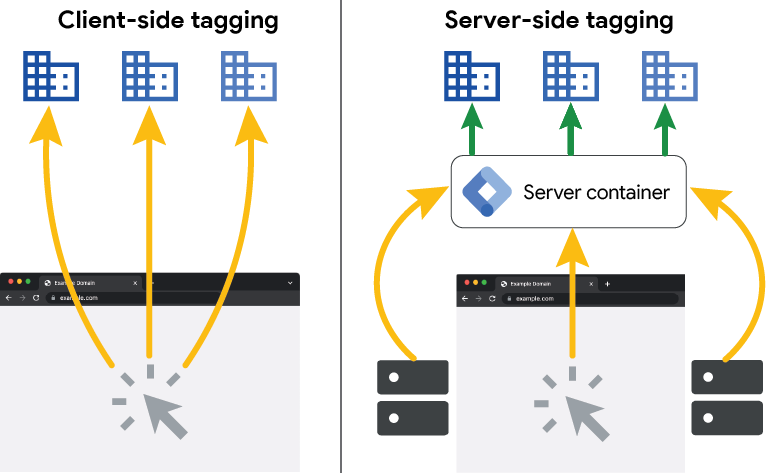As businesses in the digital era seek insights through data, the introduction of GDPR has changed the rules of the game. To help companies navigate the GDPR compliance, our comprehensive guide dives into the benefits of server-side tagging.
With the help of server-side tagging, businesses can ensure a balance between insightful data collection and user privacy. At Goodish, we’re committed to guiding you through this transition, ensuring that your business remains both informed and compliant.
“The More Data We Collect, the Better” Mantra

The mantra for many e-businesses has long been, “The more data we collect, the better.” Companies, driven by this insatiable hunger for insights, often integrate various third-party tools into their ecosystems. From Hotjar’s heatmaps to Facebook Pixel’s retargeting capabilities, from Google Tag Manager’s versatility to HubSpot’s inbound marketing prowess – these tools promise a deeper understanding of user behavior.
However, this data-driven approach often comes at a cost. Many businesses find themselves entangled in a web of data streams, losing control over the data they collect and, more critically, compromising their users’ privacy. Additionally, with the overload of these data tags, websites often become slower, leading to a frustrating user experience and diminishing the overall quality of their online presence.
Recognizing these challenges, the European Union introduced the GDPR, setting strict rules against unwanted actions like sending spam and endlessly reusing user data. It empowers users, allowing them to request access to their data or even demand its complete erasure.
The introduction of GDPR marked a pioneering move in digital privacy regulations. A new era dawned with its inception, shifting the dynamics of data collection and user rights.
Today’s users are more informed and vigilant about online privacy than ever. In response, many innovative businesses are changing ways to match what people know and care about. Instead of indiscriminately hoarding every piece of data available, they’re strategizing. By constructing precise data models, these businesses now focus on gathering only the essential data points, ensuring they collect intelligently and respect user privacy simultaneously.
What Exactly Is GDPR?
The General Data Protection Regulation (GDPR) is a comprehensive law introduced by the European Union to safeguard its citizens’ online privacy and personal data. It sets strict guidelines on how businesses handle and process personal data when users engage with online platforms.
While it’s primarily designed to protect EU citizens, its impact is global. Any website, regardless of its origin that caters to visitors from the EU must adhere to GDPR standards, ensuring that user data is collected, stored, and used transparently and securely
Essential GDPR Guidelines for Website Owners
Here are some crucial aspects to consider for compliance:
- Consent Management: Every website must have a clear privacy policy informing users about the data collection type and its purpose. This ensures users can make informed decisions about their data.
- Data Privacy: GDPR mandates stringent data protection measures and secure storage to prevent unauthorized access or breaches.
- Right to Data Erasure: Users can request the deletion of their personal data, and businesses must honor this “right to erasure” promptly.
- Compliant Data Processing: Data should be collected minimally and used only for its stated purpose, all while ensuring top-tier security.
- Transparent Data Collection: Clear disclosure of any personal data collection is a must.
- Data Protection Officer: A designated data protection officer should be in place if data collection is central to a business.
- Breach Reporting: Significant data breaches need swift reporting, ideally within 72 hours.
- Penalties for Non-Compliance: Non-adherence can lead to hefty fines, potentially up to €20 million or 4% of a business’s global annual revenue.
How Server-Side Tagging Enhances GDPR Compliance
Server-side tagging is a cutting-edge approach to data collection where most of the data handling occurs on the server, rather than directly on the user’s device. This means that instead of multiple tags on a website sending data from the user’s browser, all data goes through one main tag on the server.

This streamlined method offers several benefits in the context of GDPR:
- Simplified Tagging: Your website operates with just one main tag, reducing clutter and making data collection more efficient.
- Delayed Data Transmission: Server-side tagging can hold off on sending data, especially to places like the United States, until all GDPR safety measures are in place. This minimizes the privacy risks linked to sending data across borders.
- Enhanced Data Control and Security: Data is first stored on the host server, giving businesses more control over the information they gather. This also strengthens security and decreases the risk of privacy breaches.
- Granular Control over Data Collection: Businesses can decide exactly what data is collected and sent. This ensures that only essential information is shared, in accordance with GDPR requirements.
- Limiting Third-Party Access: Businesses can control what data third-party platforms, like Facebook, can access, preventing any unauthorized data collection.
- Handling Sensitive Information: Server-side tagging lets businesses change or hash Personally Identifiable Information (PII) before it’s sent. This aligns with the strict policies of platforms like Google and Facebook, ensuring that they only receive modified or hashed data.
- URL Modification for Compliance: URLs that might contain sensitive information, such as medical device names, can be altered before sharing with vendors to ensure no private data is unintentionally shared.
- Empowering User Data Preferences: If a user opts out of data storage or use, their choice is recorded centrally, ensuring consistent respect for their decision across all interactions.
To sum up, server-side tagging provides businesses with a powerful tool for managing data, fostering trust and transparency with users. By leveraging this method, businesses can navigate GDPR complexities more easily, ensuring both compliance and improved user experience.
At Goodish, we specialize in tracking analytics and GDPR compliance. For server-side tagging that aligns with GDPR regulations, count on us for meticulous execution. We ensure that your business remains both compliant and on the path to success.
FAQ
GDPR stands for General Data Protection Regulation. It’s a comprehensive law introduced by the European Union to safeguard its citizens’ online privacy and personal data.
While designed primarily for EU citizens, its impact is global. Any website catering to EU visitors must adhere to GDPR standards, ensuring transparent and secure data collection and usage. It’s crucial for e-businesses as non-compliance can lead to hefty fines and damage to brand reputation.
Even if a company is based outside of the EU, if it attracts visitors from the EU, it must adhere to GDPR standards. This means ensuring transparent data collection, secure storage, and giving users control over their personal data. Non-compliance can result in significant penalties.
Server-side tagging is an approach where data handling occurs on the server, rather than directly on the user’s device.
Instead of multiple tags on a website sending data from the user’s browser, all data goes through one main tag on the server.
This method reduces website clutter, enhances data control, and offers better security than traditional client-side tagging.
Server-side tagging offers several benefits in the context of GDPR. It provides granular control over data collection, limits third-party access, and ensures that only essential information is shared in accordance with GDPR requirements.
Additionally, it strengthens security, reduces the risk of privacy breaches, and respects user data preferences consistently.
The “right to erasure,” also known as the “right to be forgotten,” allows users to request the deletion of their personal data from a business’s records. Companies must honor this request promptly, ensuring the user’s data is completely removed from their systems.
With server-side tagging, websites operate with just one main tag, reducing the clutter of multiple third-party tags. This streamlined approach can lead to faster website load times, improving user experience and boosting search engine rankings.
Non-adherence to GDPR can result in substantial fines, potentially up to €20 million or 4% of a business’s global annual revenue, whichever is higher. Beyond financial penalties, non-compliance can also damage a company’s reputation and trust with its users.
Businesses should conduct thorough due diligence on third-party tools, ensuring they have clear privacy policies and adhere to GDPR guidelines. Using server-side tagging can also help control what data these third-party platforms access, preventing unauthorized data collection.
A DPO oversees a company’s data protection strategy and ensures compliance with GDPR requirements. If data collection is central to a business, having a designated DPO is essential to monitor internal compliance, inform and advise on data protection obligations, and act as a point of contact for data subjects and the supervisory authority.
If a user opts out of data storage or use, server-side tagging records their choice centrally. This ensures that their decision is respected consistently across all interactions, aligning with GDPR’s emphasis on user rights and transparency.











